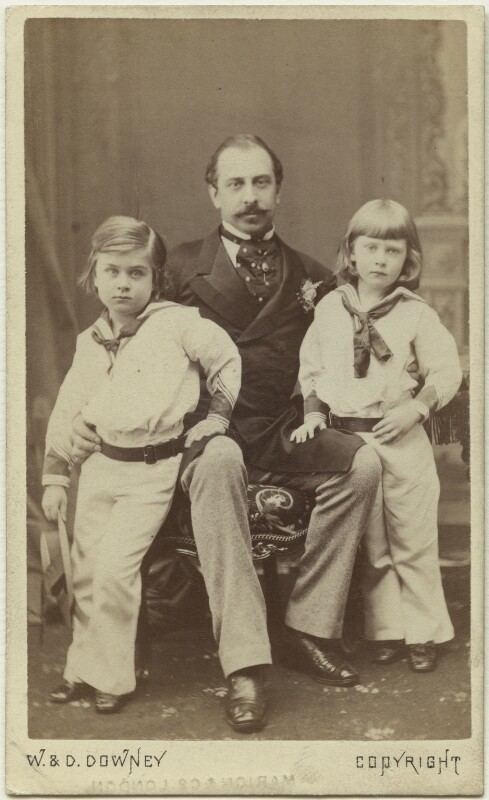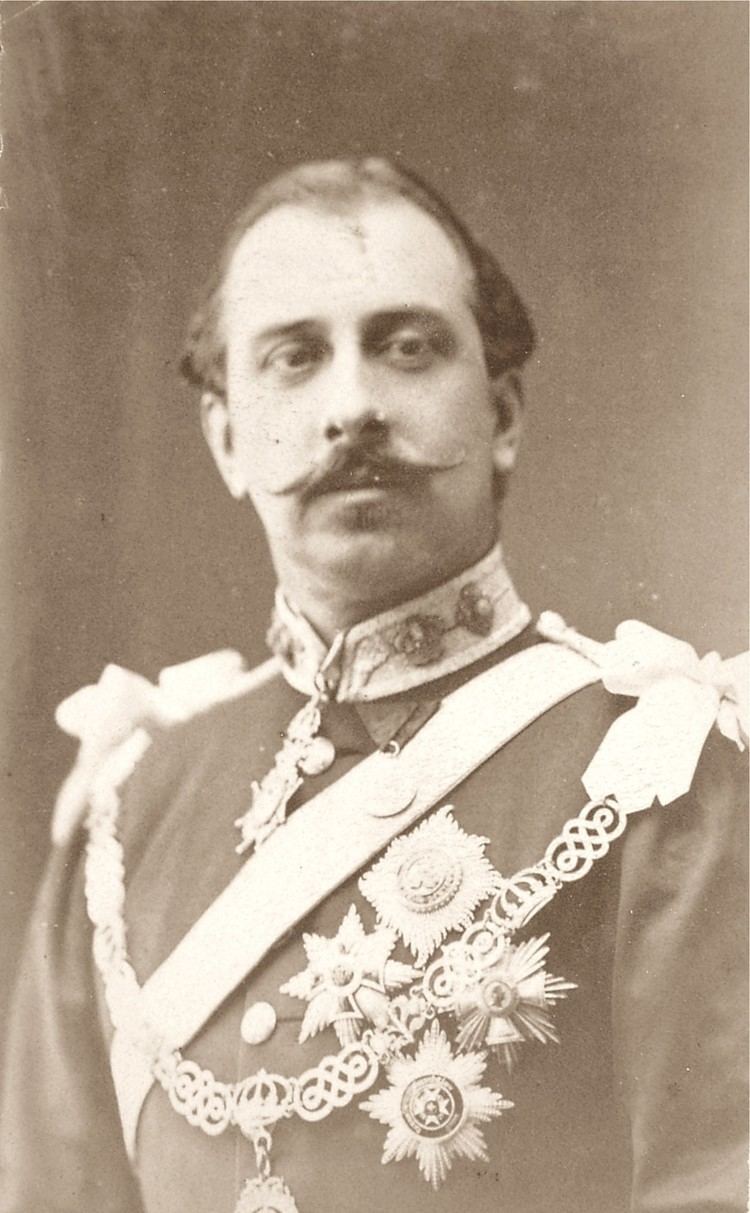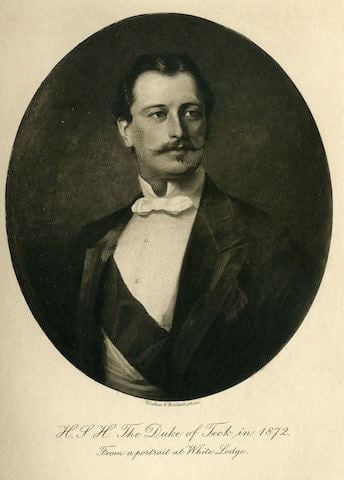Religion Lutheran Name Francis, of | House Wurttemberg | |
 | ||
Issue Mary, Queen of the United KingdomAdolphus Cambridge, 1st Marquess of CambridgePrince Francis of TeckAlexander Cambridge, 1st Earl of Athlone Father Duke Alexander of Wurttemberg Mother Countess Claudine Rhedey von Kis-Rhede Children Mary of Teck, Prince Francis of Teck Parents Countess Claudine Rhedey von Kis-Rhede, Duke Alexander of Wurttemberg Similar People Mary of Teck, Princess Mary Adelaide, Prince Adolphus - Duke of C, Alexander Cambridge - 1st Earl of, Countess Claudine Rhedey v | ||
Francis, Duke of Teck (Francis Paul Charles Louis Alexander; 28 August 1837 – 21 January 1900), until 1863 known as Count Francis von Hohenstein, was a member of the German nobility, and later of the British Royal Family. He was the father of Queen Mary, the wife of King George V, and therefore a great-grandfather of the present queen. Francis held the titles of Count of Hohenstein (Graf von Hohenstein), Prince (Fürst) and later Duke of Teck (Herzog von Teck) and was granted the style His Serene Highness in 1863. He was granted the British style of Highness in 1887.
Contents
- Background and early military career
- Marriage and dukedom
- Later military career
- Later life
- Titles
- Honours
- References

Background and early military career

Francis was born Franz Paul Karl Ludwig Alexander on 28 August 1837 in Esseg, Slavonia (now Osijek, Croatia). His father was Duke Alexander of Württemberg, the son of Duke Louis of Württemberg. His mother was Countess Claudine Rhédey von Kis-Rhéde. The marriage was morganatic, meaning that Francis had no succession rights to the Kingdom of Württemberg. His title at birth was Count Francis von Hohenstein, after his mother was created Countess of Hohenstein in her own right by Emperor Ferdinand I of Austria.

He was educated at the Imperial Austrian Academy of Engineers from 1849 to 1853 and joined the Imperial Austrian Army as a lieutenant in the 1st Lancers in 1854. He transferred to the Guard Squadron in 1858 and later became a Captain (Rittmeister) in the 7th Hussars. He served as Orderly Officer under Count Wimpffen in Italy during the Austro-Sardinian War and was awarded the gold medal for distinguished service at the Battle of Solferino and the bronze war medal, 1859.

In 1863, Francis was created Prince of Teck, with the style His Serene Highness in the Kingdom of Württemberg. He served during the Austro-Prussian War and retired from the Austrian Army when he married and moved to England in 1866.
Marriage and dukedom
As the product of a morganatic marriage, and without succession rights to the throne, Francis was not acceptable as a husband for princesses in most of the European royal houses. He further had little income in comparison with other European princes. He thus married into a richer family, by marrying his father's third cousin (in descent from King George II of Great Britain) Princess Mary Adelaide of Cambridge, the younger daughter of Prince Adolphus, Duke of Cambridge, and a granddaughter of George III, who was known as 'Fat Mary' because of her wide girth. That, together with the fact that she was (by 1866) already in her thirties, meant that Mary Adelaide was also short of choices for marriage.
The couple married on 12 June 1866 at St Anne's Church, Kew, in Surrey. They had one daughter and three sons:
He was created Duke of Teck by the King of Württemberg in 1871.
Later military career
Teck was made Honorary Colonel of the 1st City of London Artillery in 1867 and Honorary Colonel of 49th Middlesex Rifle Volunteers (Post Office Rifles) on 16 August 1876, a position he held until his death.
He was attached to the staff of British General Sir Garnet Wolseley during the Egyptian campaign of 1882. He received the silver medal for the Battle of Tel-el-Kebir, the Khedive's Star, and the Order of Osmanieh, first class. On his return from Egypt he was gazetted a Colonel in the British Army.
The Duke of Teck was made Colonel (Oberst) à la suite of the 25th (1st Württemberg) Dragoons "Queen Olga" on 6 March 1889, and a Generalmajor in the German Army on 18 October 1891. He was made a supernumerary Major-General in the British Army in July 1893 and a Generalleutnant in the German Army on 18 April 1895.
Because Francis had no inheritance, the couple lived on Mary Adelaide's Parliamentary allowance of £5,000 per annum (equivalent to ca. £525,000 in 2013), supplemented by income from her mother, The Duchess of Cambridge. Mary Adelaide's requests to her cousin, Queen Victoria, for more funds were met with refusal; however, they were granted a grace-and-favour apartment in Kensington Palace, London and a country house, White Lodge, the former Royal deer-hunting lodge in Richmond Park, Southwest London.
The Duke and Duchess lived beyond their means, leading to the build-up of large debts. In 1883, the Tecks fled the UK to continental Europe, where they stayed with relatives in Florence and Germany. They eventually returned to the UK in 1885.
Later life
With an Order in Council on 1 July 1887, Queen Victoria granted Francis the style Highness, as a gift to celebrate her Golden Jubilee. Despite this, the Tecks were still seen as minor relatives, with little status or wealth. Their fortunes improved when their only daughter, Princess Victoria Mary of Teck (known as May to her family) became engaged to the second-in-line to the British throne, Prince Albert Victor, Duke of Clarence. There was initial opposition to the match from the Duke of Clarence's parents, the Prince and Princess of Wales: Arthur Balfour wrote to Lord Salisbury in 1890 that "(t)he Teck girl they won't have because they hate Teck and because the vision of Princess Mary haunting Marlborough House makes the Prince of Wales ill." Nevertheless, the Queen gave her official consent to the engagement on 12 December 1891. The death of the Duke of Clarence only six weeks later looked like a cruel blow. However, Queen Victoria was fond of Princess May and consented when the Duke of Clarence's brother (and next in the line of succession), Prince George, Duke of York, decided to marry her instead.
In 1897, the Duchess of Teck died, leaving Francis a widower. He continued to live at White Lodge, Richmond, but did not carry out any Royal duties, although he continued to receive the late Duchess' Parliamentary annuity.
In Who's Who the Duke of Teck listed his recreations as "a little of all". He was President of the Royal Botanic Society and a member of numerous clubs, including White's, the Marlborough Club, the Bachelors' Club, the Army and Navy Club, the United Service Club, the Cavalry Club, the Naval and Military Club, the Travellers' Club, the St George's Club, the Hurlingham Club, the Ranelagh Club and the Jockey Club, as well as the Adels-Casino at Vienna and the Herren-Casino at Stuttgart.
The Duke of Teck died on 21 January 1900 at White Lodge. He was buried next to his wife in the Royal Vault at St. George's Chapel, Windsor.
There is a pub in Earls Court, London, called the Prince of Teck; there has been a pub on the site since at least 1832.
